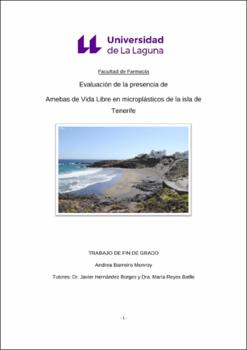Evaluación de la presencia de Amebas de Vida Libre en microplásticos de la isla de Tenerife
Author
Barreiro Monroy, AndreaDate
2020Abstract
Microplastics are small plastic particles (5 mm-1 µm size) that come from the
degradation of bigger plastics or have already been manufactured with this size
for specific uses.
Due to the degradation they suffer, microplastics can be accumulated in the
environment, being a source of contamination. Moreover, they can be ingested by animals like birds or fishes. Besides, it has been recently studied that exists a certain relation between microplastics and microorganisms, being suitable habitats for their growth and development.
In the present work, it was studied the presence of free-living amoebas (FLA)
in microplastics from sea water and sand collected in Playa Grande, Tenerife.
FLA, a group of protozoa, are widely distributed in the environment, being
causal agents of some serious infections that can affect the Central Nervous
System (CNS), such as blinding keratitis and granulomatous encephalitis.
We have isolated Acanthamoeba spp. from the microplastics extracted on the
sand. It was observed the stellate morphology of this genus cysts. The sample
was analyzed at the microscope and confirmed by the specific PCR.
These preliminary results show that, there could be a positive relation
between the growth of FLA and microplastics, making them an ideal habitat for their development.





